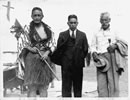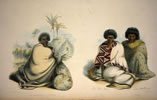The long struggle of the Kīngitanga (King movement) for recognition has been vital to Waikato Māori. King Tāwhiao declared peace to government representatives at Alexandra (Pirongia) in July 1881, and returned with his people to Waikato in 1889. They and subsequent generations never ceased to demand acknowledgement that the land confiscations were unjust. Kīngitanga deputations visited England in 1884 and 1914 to seek the support of the British Crown, without success.
The Kauhanganui
A Kīngitanga parliament, the Kauhanganui, was established at Maungakawa about 1890. Its location near Cambridge – where the Native Land Court had for the previous decade been converting collective Māori title to eastern Waikato land into individual titles, so it could be more easily divided and sold to Pākehā – was symbolic. The Kauhanganui was a rallying point for the Kīngitanga tribes. It had a council of 12 tribal representatives (called the Tekau-mā-rua), and its 1894 constitution set up courts and police to replace Pākehā institutions. A printing press was used to produce the newspaper Te Paki o Te Matariki. The Kauhanganui shifted around the region in the following years.
Te Pou o Mangatāwhiri
To raise money for the establishment of Tūrangawaewae marae, Te Puea Hērangi formed a group called Te Pou o Mangatāwhiri, which travelled around the North Island in the 1920s giving performances of waiata and haka. Its name referred to the northern Waikato boundary, the Mangatāwhiri River, which British troops had crossed to begin the invasion of the region. In the 2000s another Tainui kapa haka (traditional Māori performing arts) group kept this meaningful name alive.
Tūrangawaewae
Tāwhiao’s successors, Kings Mahuta and Te Rata, lived at Waahi pā, near Huntly, from the 1890s. In the early 1920s Te Rata’s cousin, Te Puea Hērangi, began her efforts to re-establish Ngāruawāhia as the centre of the Kīngitanga. She and her supporters moved there in 1921 and founded a community around Tūrangawaewae marae. She worked with politicians such as Apirana Ngata to develop remaining Māori-owned land and rebuild the Kīngitanga’s economic power. She became well-known to Pākehā as ‘Princess’ Te Puea.
Limited settlement
A 1927 government inquiry, the Sim Commission, declared the confiscation of Waikato lands unjust. Negotiations from the 1930s brought limited compensation in 1946. This was administered by the Tainui Maori Trust Board. Kīngitanga leaders were not satisfied, believing that the government’s payment of a token annual sum was an admission of their guilt. As land had been taken, land should be returned.
Raglan golf course protest
Continuing encroachment on Māori land rankled. The hīkoi (land march) of 1975 brought this to the notice of all New Zealanders, as did a dramatic sit-in protest at Raglan in 1978. Māori land there had been taken for a military airfield in 1941 but was later used for a golf course. When there were plans to extend the golf course into tapu areas in the mid-1970s, Eva Rickard led opposition. The land was finally returned to Māori in 1987.
Settlement act
The land protests of the 1970s and the establishment of the Waitangi Tribunal in 1975 created a political climate in which the Waikato Raupatu Claims Settlement Act 1995 could eventually be passed. Signed into law by Queen Elizabeth II in the presence of the Māori queen, Dame Te Atairangikaahu, the settlement included some land, $170 million in compensation, and a formal apology for the devastation caused by the war and confiscations.
The 21st century
In the 2000s the Kīngitanga includes traditional practices and a modern corporate structure. The poukai, an annual series of visits by the king to Kīngitanga marae in and beyond the Waikato region, dates back to the time of Tāwhiao. So does the Tariao faith, combining Pai Mārire karakia and Kīngitanga ritual, which is used in many ceremonies.
The annual Koroneihana (coronation) hui, another long-standing tradition, brings together tribes from around the country for several days of celebrations and sporting events at Tūrangawaewae.
Assets from the 1995 settlement are managed by a company, Waikato-Tainui Te Kauhanganui Incorporated. The Kauhanganui is sole trustee; its 193 members represent 65 marae.
Economic recovery
The 1995 settlement increased Māori commercial and political influence in Waikato. In Hamilton, for example, Tainui Group Holdings became owner of some central-city sites, the major shareholder in two hotels – the Novotel Hamilton Tainui and the Ibis Hamilton Tainui – and co-developer of The Base, a huge retail centre at Te Rapa.




